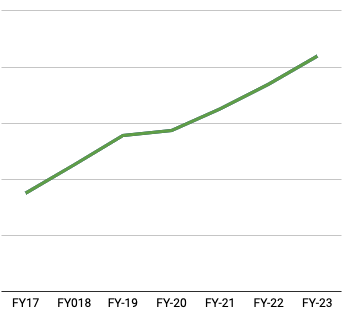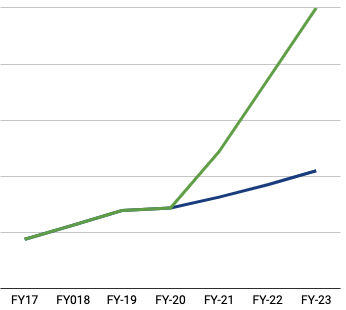
by Bill Poole | Apr 6, 2021 | Strategy
To hit your goals you need competitive advantage. How can you create strategic advantage in your competitive marketplace where imitating competitors seem to frustrate your efforts to differentiate?
The answer for strategic advantage comes through customer experience.
As entrepreneurial companies that focus on operational excellence, the tendency is to think about driving new operational efficiencies to lower costs. We might also think about launching new products. While these are essential, they can be easily imitated.
The reality is that competitive advantage can be created based on how you deliver your products and services—your customer experience.
In his famous Harvard Business Review article, “What is Strategy”, Michael Porter defines strategic positioning as “the creation of a unique and valuable position involving a different set of activities.”
The way your company delivers products and services creates your strategic position. This means that you can create strategic advantage as you transform your buyer experience and customer experience.
Consider Uber. For people wanting to get from point A to point B, taxi cabs were the only option. Through the eyes of a customer, Uber looked at every stage of the buyer experience (finding and waiting for a driver) and the customer experience (riding in the cab and paying). This led them to improve every stage of the experience.
Yes, Uber created an app which drover operational efficiencies, but the app was primarily an enabling technology to make the experience better for the buyer. As a result of strategically positioning their company by improving customer experience, Uber generates almost $1 BILLION in revenue each month!
What do your buyers want? What could you do differently than your rivals at every stage of the buyer experience to create a more strategic position versus your rivals?
In their groundbreaking work, The Experience Economy, Joseph Pine and James Gilmore say, “Even the most mundane transactions can be transformed into memorable experiences.”
What could you do to improve your customer experience? What if you applied creativity to each stage of your customer journey from the time a prospect first encounters your company through their entire lifecycle with you?
Michael Porter says, “The essence of strategic positioning is to choose activities that are different from rivals.” What could you do differently to create strategic advantage in your market?

by Bill Poole | Mar 23, 2021 | Strategy
 I look forward to visits to the Apple Store. As a fan of the brand and a tech nerd, visiting any Apple facility is a joy to me. (I even went out of my way to see the visitor center at Apple’s corporate headquarters last time I was in Silicon Valley.)
I look forward to visits to the Apple Store. As a fan of the brand and a tech nerd, visiting any Apple facility is a joy to me. (I even went out of my way to see the visitor center at Apple’s corporate headquarters last time I was in Silicon Valley.)
So, last week when my wife said that she wanted to go to the local Apple store to get a new iPad, I gladly offered to go with her.
When I arrived at the store, there was a security guard watching the door. In the tent, another security person interrogated us, asking us why we were there. After explaining that we wanted to buy an Apple product, she then told us to wait our turn.
Understanding that accommodations need to be made, we waited patiently for our opportunity to go in the store. Surely the in-store experience would be better. After all, Apple is the gold standard for customer experience.
In the store, we found a makeshift wall of white plywood with booths kind of like a ticket booth at the train station. Behind the glass, the employee barely welcomed us or thanked us for coming in. Instead, they asked for our order number. We explained that we hadn’t placed an order. Instead, we decided to drive 30 miles to the store so we could see the various models of shiny new iPads. The store employee apologized and said they were out of stock on the model we wanted. “Is there anything else I can help you with?” Nope.
I left the store dazed and confused. One of my favorite brands had confronted me with a dystopian experience.
Look, I’m not going to sell my Apple gear. The brand has 14 years of positive equity built up with me. But it got me thinking, “How does a store like Apple not get this better after a year of social distancing and updating processes for customer and employee safety?”
And, if my experience with Apple was like this, how are our clients experiencing our company?
I realize that we have all needed to make accommodations for the pandemic. I understand that going virtual is a challenge. I appreciate the reality that we need to protect our employees. I get that life in Zoom meetings or behind a sheet of plexiglass is not fun. All of this is true. However, it’s time for us to ask the question, “How can we make our experience better inside this virtual reality in which we must conduct business?”
Client Experience (CX) is critical to business success. Great experiences drive cross-sell revenue and loyalty. Poor experiences do the opposite.
Right now, it’s critical that we work as teams to improve customer experience. This applies to us for the remainder of the pandemic. It also applies as we chart our path forward beyond the pandemic.
Map Your Experience
The first step is to identify the stages of your experience. Look at it through the lenses of a prospect and client. What happens from the time they first encounter your company all the way through their time as a customer? Break it into stages. Then look at each stage and begin to ask, “How could we make this better?”
When we are leading a Revenue Growth Workshop for a company, I enjoy seeing teams of marketing, sales, and operations leaders work together to map their customer experience. Lightbulb moments happen as they put themselves in the place of their buyer or customer.
Be Intentional
“This is the way we’ve always done it” simply doesn’t cut it in this dynamic market. As a result, we must be intentional to ensure that our experience is as remarkable as possible. Plus, with so many companies delivering a poor experience right now, creating a remarkable experience is a beautiful way to shine and create a competitive advantage.
Smart companies are intentional about every single experience. In Revenue Growth Engine I use my wife’s newborn photography business as an example. She has inspired me to pay attention to the details. Even as her business was able to open up with the right safety precautions in place, she has continued to look at the details of the experience she provides to new moms. The amount of goodwill and loyalty this creates is powerful, especially in the midst of so many bad client experiences that people have.
Consider New Options to Communicate
In his book, Never Lose a Customer Again, Joey Coleman outlines six options for communication that can be used during the stages of the client experience: in person, email, mail, phone, video, and presents. Your business may have relied on in-person interactions. During the pandemic, maybe you leaned heavily on email. What could it look like if you tried some other ways to communicate. Here are some ideas to get the ball rolling:
- Send a thank you card in the mail after someone makes a purchase or meets with you
- Send a creative mailer after the first meeting. (Interesting ideas in this podcast: Nick Runyon-Tactile Marketing Automation)
- Pick up the phone and call them (Tip of the hat to Jeb Blount!)
- Send a video in place of an email to re-humanize your interactions
- Find a gift to send that aligns with your values and supports the stage of the process
What can you do to improve your client experience? Take bold steps in this area and you will build competitive advantage that will drive revenue growth!

by Bill Poole | Mar 9, 2021 | Strategy
If you look around any successful entrepreneurial business, one thing you will consistently find are processes. Well-defined and documented processes for operations, administration and finance are paramount to driving growth.
That said, if we look to sales and marketing, it is like a journey to the wild west. You will find some campaigns or sales blitzes here and there, but most businesses lack consistent, repeatable processes in sales and marketing. Why is that?
Sales and marketing are the least process-driven functions inside of most entrepreneurial organizations. There are a few possible reasons for this:
- Many entrepreneurs are very good at what they do, but sales and marketing is a bit out of their comfort zone.
- Arguably, process is not aligned with the human nature of a salesperson.
This gap in structure equates to a TREMENDOUS opportunity to drive revenue growth. The purpose of this blog is to look at:
- The benefits of implementing repeatable, aligned processes in sales and marketing, and
- Options for implementing sales and marketing processes in your business.
Benefits of a repeatable process
I have become more and more fond of processes as I have matured as a professional. I started as a sales rep and was very successful selling without having a highly structured process. Fast forward 20-something years and, as the integrator at Convergo, I oversee all of the different functions of the business and tie them together. Some of which I am more comfortable with than others.
When I get out of my comfort zone either personally or professionally, I seek to develop frameworks or processes to follow to achieve success.
One example of that is when my wife and I purchased an investment property in the mountains. I’ve owned investment properties before, but not a short term rental. So, I had two different options to manage the rental:
- Hiring a property management company: Property management companies absolutely provide value, but that value comes at a cost. They take 30% of the rental income in exchange for taking any headaches off my plate.
- Manage it myself: Obviously this takes more time and mindshare on my part than hiring a property management company.
Despite my normal preference for outsourcing, I decided to manage the property on my own.
So, how did I do this? I leveraged some subject matter expertise to create a repeatable, sustainable process that I could execute on my own. The result is way more revenue than I would have had hiring a manager (more on that later) and 100% of my reviews are 5-Star reviews on VRBO. Don’t believe me? Feel free to check it out here. If you are looking for a nice vacation in the Rockies, it is for rent as you can see!
To put the process together, I reached out to some others that have rental properties in the area and found 2 critical pieces of the equation. A reliable cleaner and a reliable handyman. As luck would have it, those that I found are a husband and wife team! We keep the place stocked with a surplus of everything that is needed in an owners closet in the garage that the cleaner has access to.
I also chose VRBO as a comprehensive platform that enables me to effectively price and market the home, manage the bookings, and make local tax payments.
After I boiled that all together, this is what my simple process looks like:
Once a quarter, I do some research on rental rates to set prices out for the next 6 months. I set the prices relatively high in the distant future because the place is a nice place and people book it given the 5 star reviews.
I take 15 minutes every other Monday to take care of a few ongoing items that allow me to maximize my revenue and keep my 5 star reviews:
- I adjust pricing in the shorter term to fill any unrented gaps. Two weeks ago, I significantly lowered the price for 2 upcoming mid-week gaps, which is rare for March. Shortly after, both weeks got rented.
- I send a text to the cleaning service with the updated rental schedule.
- I send a text and email to anyone that has recently booked to thank them, let them know what their specific door code is, and send them the rental instructions (which are also printed in the house).
I set a reminder for myself for any day a new renter arrives to send a text welcoming them, reminding them of the door code, and ensuring they know how to reach my wife and I if they need anything.
In the rare case that something goes wrong, I call the handyman and he does an AWESOME job taking care of things after I make the call. He is a bit expensive, but he takes the problem off my plate and is not nearly as expensive as a rental property manager.
So, it took a bit of effort to put the process together, but the results are great! Most of the benefits are financial:
- More revenue: I generate 19% more revenue that I would have had with a rental company because I strategically manage the pricing in a more active manner than the property management company would.
- Less cost: I save 30% of the revenue that would be paid to a management company.
- Future earnings: I have a tight, proven process that I can leverage should I want to acquire additional properties.
Obviously, I spend more time on this than I would if I hired someone to manage this ongoing, but the financial benefits far outweigh the cost. Regarding my time, quite honestly I enjoy the hospitality aspect to doing it myself as well, which you can see is reflected in the reviews.
Options for implementing sales and marketing processes in your business
There are 3 high-level options for implementing sales and marketing processes in your business:
- DIY
- Hire a long-term strategic resource
- Use outside expertise to implement processes that you can manage on your own
The skills and knowledge required to implement a process as opposed to managing a process that is already implemented are vastly different. A resource to implement a process is a significantly higher investment than a resource to manage one. We will explore the pros and cons of each with that in mind.
Option 1: DIY
Lots of businesses struggle to make progress because of a do-it-yourself mentality. A false narrative with this strategy in a lot of cases is that it is less expensive. On the surface, that may seem to be the case, but here are a few questions to consider along those lines:
- Who has the expertise in your business to be able to implement these processes?
- What other roles or responsibilities does that person have in your business?
- If that person is already in your business, why isn’t the process already implemented?
The upside with the DIY approach comes into play if you do have internal resources that have both the experience and time to pull it off.
Option 2: Hire a long-term strategic resource
Making a strategic hire like a CMO or a VP of Sales is an option to consider. The advantages of something like this is that person typically brings with them the knowledge and experience to be able to implement processes.
A few challenges with this approach are:
- Strategic hires require a significant long-term investment. The idea with implementing these processes is that they are repeatable and consistent, but it doesn’t take years and years to implement them. Once the implementation is complete, the strategic, highly compensated resource may no longer be needed.
- What is the right skill set? Sales? Marketing? It is very rare for a strategic resource to have experience in both. In addition, some strategic resources lack the project management or human skills needed to implement processes.
- If the process is implemented by a strategic hire, what happens if that person leaves? Is the process owned by the individual, or the company?
As entrepreneurial businesses scale up, it is sometimes necessary to have those strategic resources in place. That said, it could be a mistake to bring in a strategic, expensive resource too soon.
Option 3: Use outside expertise to implement processes that you can manage on your own
Bringing in outside expertise to implement processes in your business has some significant advantages. This outside expertise can come in many different flavors:
- Some are individuals with sales experience, some marketing experience, some are teams of people that bring both sales and marketing perspectives.
- Some have their own prepackaged processes, and some implement custom processes inside your business.
One may argue that bringing in outside expertise is expensive. As compared to the options above, this expense is typically a short-term expense and should be weighed against the expense of a strategic resource or the opportunity cost for some one on your team to implement processes.
It depends on the approach that the outside consultant leverages to help, but it may also be argued that external consultants bring in their own processes that are not necessarily optimized for your specific business.
There are some significant advantages to consider with regard to hiring outside expertise to implement sales and marketing processes:
- You own the process: The process that a strategic hire (option 2 above) brings into your business might might be tied to that person and could be challenging to sustain if they leave.
- The external consultant is not a long-term hire: Typically, external consultants will facilitate the implementation of processes, and then turn it over to the business to manage and make future improvements. This is the opposite scenario of hiring a strategic resource that will be paid long-term.
- Cultural benefits: We are currently working on a project with a client that reflects their company culture and their hiring process. We are working with them to implement sustainable marketing processes. A lower level person on the marketing team is actively engaged in helping build the process. Once we implement the process, that internal resource may be elevated to run the process. Not only are there financial benefits to this, but promoting from within has many cultural benefits.
- Comprehensive expertise: If you pick the right company, they may have expertise in both sales and marketing and can look at the project from a comprehensive, revenue generating standpoint.
Regardless of how you do it, implementing sales and marketing processes in your business can be a significant driver of future revenue growth.
How did the sales and marketing processes in your business compared to processes in other parts of your business?

by Bill Poole | Mar 4, 2021 | Strategy
There’s a delicate balance between setting aggressive revenue goals and achievable revenue goals. Of course you want to grow your business, but it is helpful to have some reasoning behind raising the bar to accelerate year over year revenue growth.
The same concept applies to sports teams. Hockey is a good example. A hockey team plays 82 games per year. Let’s take a look at the win trajectory of a hockey team that has had the following performance the last 4 years with roughly the same personnel:
- 2016: 42 wins
- 2017: 43 wins
- 2018: 44 wins
- 2019: 44 wins
Let’s set aside the reality of 2020 and look at what a logical goal for wins in 2020 might have been. Given the win trajectory of 2016-2019, what do you think would be a logical goal?
Unless some changes have been made by the team or some of its close competitors, a logical goal would be 45, right?
What if the coach comes into the season with a goal of 55? Sounds like a big jump given the win trajectory of the last 4 years. But 55 does makes sense if there is a plan! Possibly a new coach with a different system or maybe a few new players that are better than the ones that they replace.
If there was a goal of 55 without some sort of change in strategy, then why wouldn’t the team have won 55 games in 2019 or 2018?
When we work with clients to help them grow revenue, We begin by looking at the historical revenue trajectory. It is helpful to visualize this using a graph. A revenue trajectory based on historical performance (like the last 4 years for the hockey team) is shown here:

Then, we look at the future revenue growth goals, which is where we see revenue goals more like the 55 wins goal rather than the 45 wins trajectory. The image below is pretty typical of what we see.

The abrupt line in FY-20 showing deviation from historical performance is a typical representation of future revenue goals.
Similar to the hockey team analogy, a goal without a plan is a dream. Setting goals is a great first step. Realistically, to get off the current trajectory path and merge onto the accelerated path, you likely will need some mix of changes throughout operations, sales and marketing. Examples might include:
- Bringing on new leadership
- Reorganizing your company
- Adding some sales reps
- Investing in marketing resources
- Adding new products or services that your current clients could benefit from
While all of these strategies might make sense, some of them involve more significant change or investment than others. You would be surprised how small changes can yield big results. A couple of examples:
- Ensuring sales, marketing, and operations are aligned in providing an exceptional client experience
- Implementing sustainable sales and marketing processes in the business instead of investing in high-level leadership changes
Changes like these minimize the significant long-term investments that some of the options require. It can also have a significant impact impact on the culture and morale of your current team.
Weighing all of the options before you determine the proper course of action is most definitely a worthwhile investment of time!
What is the delta between your revenue trajectory and your revenue goals?

by Bill Poole | Feb 8, 2021 | Strategy
When I say “client experience,” what comes to mind? Take 30 seconds to ponder that question before you read on.
Let’s get a bit more specific and go back in time 5+ years. What sort of experience do you recall having with a taxi cab?
Compare that to the experience that you get when you use Uber.
How are those two experiences different from your perspective? My guess is that taxi and Uber experience likely conjured up feelings on opposite ends of the spectrum. Both of them serve the same purpose of getting you from point A to B, but the vibe that Uber facilitates is significantly different from the taxi vibe.
From the client perspective, the “vibe” is the overall feeling that they have about their entire experience they have with a brand. So what can a brand do to ensure the vibe they are creating is a positive one?
Before we dive in any further, let’s get some clarity on a few things to ensure we are on the same page as to what a client experience is by looking at a few similar terms as noted in this Forbes article:
- Customer service is the advice or assistance a company gives its customers.
- Customer care means how well customers are taken care of while they interact with the brand.
- Customer experience is the total journey of a customer’s interactions with a brand.
Customer Experience became a hot buzzword a few years ago. Consulting businesses sprung up everywhere to ensure that brands provide a positive customer experience targeting the many touch points that very large businesses had with its “customers ”(Face-to face, phone, web, printed invoices, etc).
We help entrepreneurs of small and medium-sized businesses accelerate revenue growth. Our clients refer to their “customers,” as “clients.” So, we help them optimize their “Client Experience” to ensure a positive vibe is associated with the business or brand.
This process starts with mapping out the experience that a client has with your business into the stages that they go through. Let’s turn back to the taxi/Uber analogy and look at the steps involved to go out for a nice dinner.
| Stage |
Taxi |
Uber |
| Decision Point |
Should we just drive? I would like to have a couple of glasses of wine, but I am not sure we can make our reservation on time because the taxi is not reliable. |
Looks like an 8 minute wait for an Uber and a 14 minute drive to the restaurant. Perfect, we can relax at home a bit more and request the Uber so we arrive just in time. |
| Ride Request |
Call the taxi dispatch and request a ride from the person that actually may indeed be the most miserable person on earth. |
Push 2 or 3 buttons on my phone to select what kind of car I want (large, small, luxury). |
| The Wait |
Will the taxi ever get here? We are not going to make our reservation. |
See when the Uber will pull up at the house and go outside to get in the car. |
| The Ride |
If it comes, you get in the car, the cabbie rivals the dispatch person from a misery standpoint, it is dirty, smells bad, and there is some really weird propaganda on radio. |
Car is clean, I put my music on the radio, charge my phone, have a bottled water, and chit chat with the driver if I am so inclined (which I often am). |
| The Exit |
Pay, get change and try to figure out the tip OR, give a credit card, listen to the cabbie groan about having to take a credit card, sign, and leave. |
Get out of the car and I can tip the next day if I want. I can also split the charge easily with other riders. |
| Arrival |
Miss your reservation or need to apologize for being late. |
Walk in, sit down, and enjoy a great dinner. |
We are client experience geeks here at Convergo and we feel as though the starting point for creating the Client Experience is to map it out in a similar way that you see above (Decision, Ride Request, The Wait, etc).
There are 2 high-level reasons why you would want to do this:
- It provides a framework for differentiation and improvement.
- It helps to align your team.
Framework for Differentiation and Improvement
It is harder and harder to differentiate the products and services that you sell to your clients BUT it is very difficult to copy a client experience.
Mapping out the Client Experience provides a framework for differentiation and improvement. Breaking down the stages and making improvements to all of the stages provides a better result than trying to differentiate from a macro standpoint. It gives you specific moments in time to zero in on to begin optimizing.
Align Your Team
Let’s turn back to what I would assume to be the structure of a taxi business. I can only assume that an owner of a taxi business thinks of the different departments needed to run the cab company:
- Dispatch
- Drivers
- Vehicle maintenance
- Back office
Given the touch points noted above, it is hard for me to believe that there is any consideration given to how the client feels in any of these functions.
Sales, Marketing, and Operations traditionally exist in silos in many organizations in a similar way that these departments run a taxi business.
The big shift to Client Experience actually through the lens of the client allows you to think about:
- What the client needs to have a pleasant experience in each stage
- THEN, what is the role of Operations, Sales, and Marketing to facilitate that pleasant experience.
The taxi vs Uber discussion is a great example of how this all comes together. In closing, a couple of questions:

by Bill Poole | Jan 6, 2021 | Strategy
The Convergo Approach Series
Part 1: The Difference Between Convergo and a Marketing Agency
Part 2: A Strategic Approach
Part 3: The Lens of the Ideal Client Experience
Part 4: Sales and Marketing Integration
Part 5: Sales and Marketing Processes
Considering the experience that your prospects and clients have with your business is a very good lens to use when you’re deciding where to invest in sales and marketing. We call this the Ideal Client Experience. This process is two steps:
- Documenting your Ideal Client Profile: Ensuring the Ideal Client is clearly defined
- Mapping out your Ideal Client Experience: Looking at the entire experience that an Ideal Client has with your business.
Ideal Client Profile
Most clients that we work with have a good idea who their ideal client is. Ideal clients are those that can take advantage of everything you have to offer.
As we work through the workshop process, clients often realize that their definition of an ideal client may be too broad. This makes it very difficult to create effective messaging and content that will connect with your ideal clients and also very challenging to get on their radar. Here are a couple of helpful resources about your ideal client profile:
When the ideal client is further refined, the value proposition can often be improved. We recently worked with a financial services company on a Revenue Growth Plan. When we worked through clarifying their Ideal Client Profile, they had the lightbulb moment that our clients often experience.
Initially, they wanted to hire a marketing person to get more leads. Going through our process helped them realize that the quickest way to achieve revenue growth (which is their overall goal) was to expand their share of wallet with their existing clients. Interestingly, this shift in thinking helped them decide to leverage existing educational resources for their clients to better serve them.
In the end, the value proposition to their clients is improved, enabling them to sell more to their current client base instead of hiring a marketing person right out of the gate to generate more leads. The next step is to make an investment in a marketing person to leverage this enhanced value proposition. The result? More QUALIFIED leads that are aligned with their Ideal Client Profile.
A tight value proposition targeted at a well-defined ideal client is a must before executing on a marketing strategy whether you are using an agency or doing your own marketing.

Mapping Out Your Ideal Client Experience
Taking the time to map out the experience that your ideal client has with your business is a very valuable exercise. That experience begins when your ideal prospect has a problem that you might be able to help with and ends when they are enjoying all of your products and services. The documentation of each stage that your prospect/client goes through is what we call the Ideal Client Experience (or ICX). Here are a couple of considerations to keep in mind when mapping out this experience:
- Ensure you think about it from the lens of your client and not from your internal sales or delivery process. Thinking about how clients feel in each stage and the friction that they might experience is a great framework for improvement. This lens allows you to be more objective in considering a sales and marketing direction. It often brings operations into the equation as well as they obviously have a significant role in maximizing the client experience.
- Do not have any pre-dispositions as to where you can make the biggest impact. More on why below.
More often than not, businesses come to us thinking they need more top-funnel marketing leads to drive revenue growth. 2 thought-starter questions on this topic:
- How many of your clients actually fit your Ideal Client Profile (Read: They can take advantage of everything you offer)?
- What percentage of your ideal clients actually are enjoying all of the products and services that you offer? Follow up question: Why is your number so low?
Like the financial services company mentioned above, looking at the ideal client experience also helps prioritize where you can make the biggest impact the soonest. In addition, one significant advantage of looking at the ideal client experience to support your investment in sales and marketing is that it becomes a lot easier to measure than traditional marketing spend.










